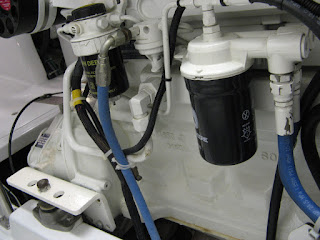Wet and windy =
maintenance days
As the nice gales and accompanying rain worked their way through,
we stocked up on bulk stores before we get to places which only have small
local shops. We also did a little maintenance.
For the technically minded or very bored:
The main engine has a big multi-V belt which drives the
coolant pump and domestic alternator (ie the big one that can make 175 amps at
24 volts). It transmits lots of power when the alternator is working hard and
it had started to get a bit noisy, suggesting that it was beginning to wear. It
wasn’t slipping at all even under high loads and there were no signs of
cracking or uneven wear though. So, because there was some time aboard during
the rain, we decided to change it. 1,500 hours isn’t approaching the normal
replacement time but better to be safe than sorry.
Should be a simple job – remove the covers over it (there
are 3, see above), the 2 drive belts for the engine battery alternator which
sit in front of it and then pop the belt off. Well, no….
The nice stainless steel rail around the engine as installed
in the factory sits right in front of one bolt that holds the guard to the
small alternator belts in place. The bolt was too long to remove as it hits the
guardrail. Brilliant thinking from someone who knew they would never ever have
to do this job…
As preparation, a couple of spare bolts had already been
procured so the original could be loosened and then cut off. Then the 3 covers could be loosened but only
1 removed thanks to the large coolant hose which flows across them and down to
the keel cooler (see first picture).
“Lugger Bob” is a technical training instructor for Alaska
Diesel, who produce the Lugger engine using a John Deere base unit. He is a
huge friend to the Nordhavn boating community and great resource. He offers
many practical maintenance tips via the owners Yahoo group and had mailed
another owner to say that belt replacement is possible “with some trickery” to
thread the new belt through the remaining covers, small alternator belts etc.
Otherwise, you have to drain down the engine coolant and remove the big, very unwieldy
hose then refit it. Oh no!! Too hard.
So, with “some trickery” the replacement was achieved and
the mischievous bolt replaced but back to front so we only need clearance for a
nut now, not the whole bolt. Kind of satisfying, but a messy job. There was
plenty of nice black belt dust inside the covers (showing that there was a fair
bit of wear) which wanted to invade the engineroom. A short test to check that the noise had gone – worth the “trickery”
and black hands, fingernails etc.
To be fair, this is the one part of the main engine that is
hard to access. As the expected belt life is well over 2,500 hours depending
upon engine room temperatures / load, we cannot complain too much. Normal maintenance
work on the engine is easy as everything is so accessible and designed for quick
replacement. Oil, fuel and air filters are right in front of you:
In our view, there are a few critical things about your machinery
if you want to be a live-aboard and do some long distance cruising:
Manufacturer backup / advice – the official manuals
are usually almost useless, often just covering major rebuilds. We hope not to have to do that! Practical tips from “Lugger Bob” are priceless
(eg how to perform some tasks without the John Deere special tools,
troubleshooting advice based on practical experience etc.)
Parts prices – our main engine needs John Deere
maintenance parts and they are “Farmer” prices, not “leisure marine” like Volvo
Penta, Yanmar etc. As an example, we can buy 3 Deere oil filters for the price
of 1 Yanmar unit for our last boat. Fuel filters – the ratio is more like 4:1!
Simple, robust engineering – if it goes wrong and you
are underway or anchored off a small island somewhere, it is good to be able to
fix it without a diagnostic laptop and links back to the factory for codes etc.
We carry several spare parts for things
that could cause trouble (eg starter motor solenoid, fuel lift pump, thermostat)
and most could be fitted by the ham-fisted Captain even whilst underway. For
anything that needs a specialist workshop, the Lugger engine is low tech (no
common rail injection for example) rugged and simple to work on.
Belt and braces installation – the Nordhavn is great
in this respect (apart from the stainless rail in front of the bolt of course!)
Huge over specified duplex fuel filters, heavy duty couplings and fittings,
aircraft style fuel lines and fittings etc etc. There is a day tank for fuel
which is topped up from the main storage tanks via a filter if wished to ensure
nice clean fuel by the time it gets to the engine (remember the old adage about
diesels – give them air and clean fuel and they usually keep working)
Main engine filters / vacuum gauge and the polishing filter
Fuel flow valves – so you can move fuel from and to pretty
much anywhere and polish it en route too
Our view is simple. Preventing things from failing is
priority 1. Having a backup in place that can be used if they do is prio 2.
Being able to fix it underway is prio 3. Getting home just using the little wing
engine is prio 4. Calling the lifeboat isn’t high on our priority list…




